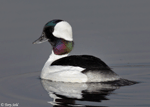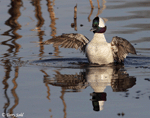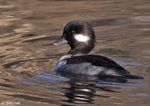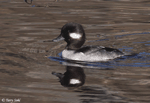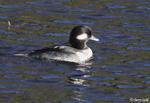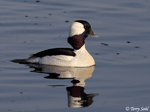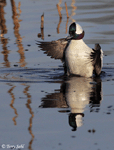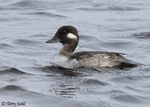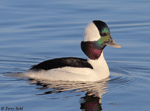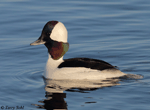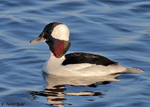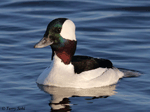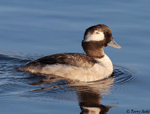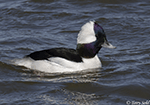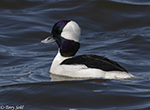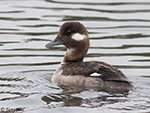| Length: 14 to 16 inches | Wingspan: 20 to 24 inches | Seasonality: Migrant |
| ID Keys: Large white patch on back of head, black back and remainder of head, white body | ||
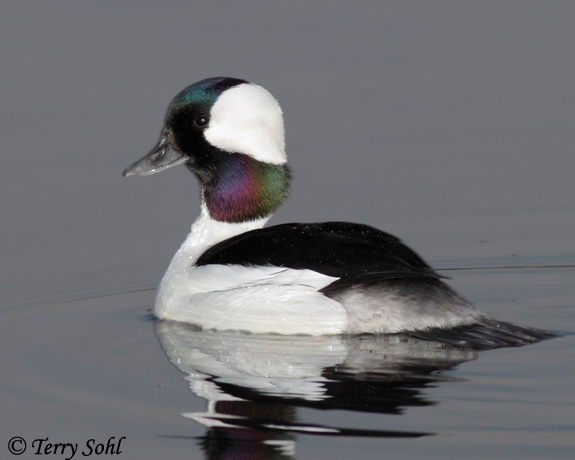 One of the smallest ducks
found in the state, the Bufflehead can be distinguished by the male's large
white patch on the back of its otherwise black head. Its small size allows
it to use nest cavities of Flickers and other
similarly sized cavities, giving it an ample supply of nesting locations,
particularly as a large number of Wood Duck
boxes have been erected in recent decades. They
are a diving duck, feeding underwater. As with many duck species in the United
States, populations have rebounded strongly in recent decades.
One of the smallest ducks
found in the state, the Bufflehead can be distinguished by the male's large
white patch on the back of its otherwise black head. Its small size allows
it to use nest cavities of Flickers and other
similarly sized cavities, giving it an ample supply of nesting locations,
particularly as a large number of Wood Duck
boxes have been erected in recent decades. They
are a diving duck, feeding underwater. As with many duck species in the United
States, populations have rebounded strongly in recent decades.
Habitat:
Prefers small ponds and lakes with surrounding woodland for breeding. Winters on small ponds, lakes, and rivers inland, also in shallow bays and estuaries along the coasts.
Diet:
Primarily insects and insect larvae in the summer. Primarily crustaceans and mollusks in the winter. Also will occasionally eat plant material.
Behavior:
Nearly always feeds by submerging and obtaining food underwater. Buffleheads are not as gregarious as many ducks, and are often found in pairs or small flocks.
Nesting:
June and July in their North American Range. Buffleheads are cavity nesters, typically using old burrows of woodpeckers or other burrows when available (including nest boxes). They are monogamous, with birds often returning to the same nesting location year after year. The female lays between 7 and 10 eggs, and she alone incubates them. The eggs hatch after about 4 weeks. The young leave the nest only a day after hatching, and may be tended to by the female as they grow, but the young find their own food.
Song:
Males have a harsh chattering call when displaying and interacting during courtship. Females have a harsh cluck often given in flight.
1Click here to hear the single-note calls of a female/immature male
Migration:
Summers primarily in Canada and Alaska. Winters along North American coasts, throughout much of the southern half of the U.S., and points south.
Interactive eBird Map:
Click here to access an interactive eBird map of Bufflehead sightings
Similar Species:
A male Bufflehead could perhaps be confused with a Hooded Merganser, as they both share the same kind of large white patch on the back of the head. However, the male Bufflehead is all black and white (with iridescence in the black plumage on the head), while the male Hooded Merganser's body is brown on it's lower half. In addition to other plumage differences in the black and white plumage, the bill shape is also dramatically different, with the Hooded Merganser having a thin bill designed to capture fish, while a Bufflehead has a more typical duck-like bill seen on many diving and dabbling ducks.
Birdhouses:
Will use appropriately sized nest boxes near water.
Conservation Status:
As with many waterfowl species in the United States, conservation efforts, reasonable hunting regulations, and restoration of habitat has led to a strong increase in populations over the last few decades. Bufflehead are common in many parts of a very large range. The IUCN considers the Bufflehead as a species of "least concern".
Further Information:
Photo Information:
April 11th, 2010 - Dewey Gevik Nature Area, South Dakota - Terry Sohl
Additional Photos:
Click on the image chips or text links below for additional, higher-resolution Bufflehead photos.
Audio Credits:
1Paul Marvin, XC361916 - Source information at: https://www.xeno-canto.org/361916
| Click on the range map for a higher-resolution view |
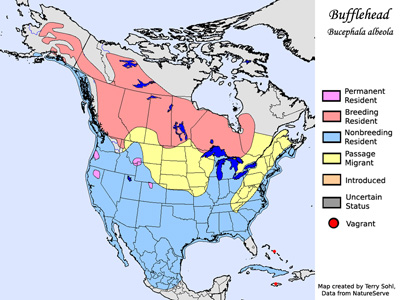 |
| South Dakota Status: Common migrant in the eastern part of the state, less common in the west. Uncommon in winter. |
Additional Bufflehead Photos
Click for a higher-resolution version of these photos
